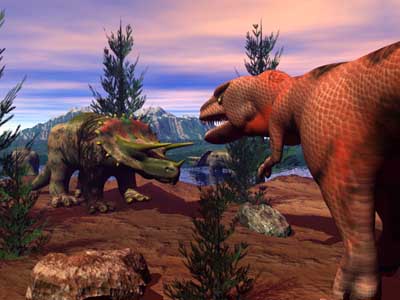pop up description layer
HOME
Cryptozoology UFO Mysteries Aviation Space & Time Dinosaurs Geology Archaeology Exploration 7 Wonders Surprising Science Troubled History Library Laboratory Attic Theater Store Index/Site Map Cyclorama
Search the Site: |
|
What's a Dinosaur?
Dinosaurs, contrary to what many people think, are not just big lizards. While it is true that the name dinosaur (coined by Sir Richard Owen in 1842) means "terrible lizard" in Greek, dinosaurs are quite a distinct group from lizards. The first dinosaur bones were discovered in 1822 in Sussex, England, by Gideon Mantell. It was a herbivore (plant eating) dinosaur later given the name Iguanodon. Shortly after the Sussex discovery the first carnivorous dinosaur, a Megalosaurus, was found. Dinosaurs are considered to be reptiles. Unlike most reptiles dinosaurs all walked with their legs directly below their hips. This is different than a lizard or a crocodile where the top section of the limb is splayed out horizontally from the body and the lower section goes from the "knee" joint straight down to the ground. Because of this lizards and crocodiles move low to the ground and almost appear to be dragging themselves around on their bellies. In contrast, dinosaurs walked in an upright manner (Though a few species, like Triceratops, did retain the lizard-like sprawl on it's front legs as it lumbered about). We can tell dinosaurs walked with their feet under their hips by carefully examining the way their bones go together. Everything we know about these ancient creatures is based on the few fossilized skeletal remains we find. None of the soft tissue of the dinosaur's bodies have survived the past 65 million years of time except for a few, rare skin and footprint impressions left in rock. Also, unlike other reptiles, many scientists believe that dinosaurs were at least partly, "warm-blooded." (Though new evidence has called this theory into question.) That is, they used their metabolism to control their temperatures, instead of depending on the environment. Snakes and other reptiles adjust their body heat by moving into the sun or moving into the shade as need be. If a reptile gets too cold he will slow down or even go into a state of hibernation. Warm blooded animals, like mammals and birds, maintain a constant temperature (in the case of people it's 98.6 degrees Fahrenheit) no matter their activity or environment. This allows mammals and birds to be active and quick moving in even cold climates. To maintain a constant temperature requires tremendous amount of energy, though. Much more energy, per pound of animal, than cold blooded animals use. The Mesozoic Era was divided into three smaller periods: The Triassic, from 254 to 204 million years ago; the Jurassic, from 204 to 140 million years ago; and the Cretaceous, from 140 to 65 million years ago. During these periods a huge variety of different dinosaurs developed. A common misconception is that all dinosaurs were on Earth at the same time. Dinosaurs living during the Triassic, like the plant eating Plateosaurus, are actually further distant in time from the Cretaceous Tyrannosaurus Rex than we are today. Dinosaurs came in many sizes. One of the smallest, Compsoganthus, was the size of a chicken. The largest were the Sauropods (Four legged dinos with long tails and long necks) like the Apatosaurus and the Diplodocus and could grow to be 90 feet long. The largest meat eating was the famous Tyrannosaurus Rex which stood upright on two legs. His head was 20 feet in the air and his body stretched some 46 feet in length. Other dinosaurs came in unusual shapes. The plant eating Triceratops had three sharp horns on it's bony head for defense. Others like the stegosaurs used a club, covered with sharp spikes, on the end of their tails to protect themselves. Ankylosaurus also had a club, but without spikes. He got additional protection from heavy armor plating that covered his entire body turning him into a living tank. A couple of other things about dinosaurs: They had neither flippers or wings. Animals that lived in the sea during the age of the dinosaurs were marine reptiles, like the plesiosaur, not dinosaurs. The flying reptiles, like the pterodactyl, are not considered dinosaurs either. Even though dinosaurs didn't fly they do seem to be closely related to modern birds. Theropod dinosaurs (those that walk upright on two feet like Tyrannosaurus Rex) share some bone structures with birds that are seen in no other group of animals. So what is a dinosaur? A reptile that lived between 220 million years ago and 65 million years ago, walked with its feet below it's hips, was maybe warm-blooded, had neither flippers or wings, and is closely related to modern birds. They just aren't oversized lizards.
Copyright Lee Krystek 1996. All Rights Reserved.
|
|
Related Links |
|
|





 It is believed that
from about 230 million years ago, to 65 million years ago (The
Mesozoic Era) dinosaurs were the dominant form of life on Earth.
At the end of the Mesozoic, dinosaurs, and many other species
of life, went
It is believed that
from about 230 million years ago, to 65 million years ago (The
Mesozoic Era) dinosaurs were the dominant form of life on Earth.
At the end of the Mesozoic, dinosaurs, and many other species
of life, went 